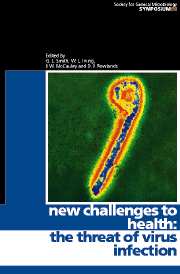Book contents
- Frontmatter
- Contents
- Contributors
- Editors' Preface
- 1 The viruses in our past, the viruses in our future
- 2 Dynamics and epidemiological impact of microparasites
- 3 The continuing threat of bunyaviruses and hantaviruses
- 4 Calicivirus, myxoma virus and the wild rabbit in Australia: a tale of three invasions
- 5 Potential of influenza A viruses to cause pandemics
- 6 The hepatitis viruses as emerging agents of infectious diseases
- 7 The emergence of human immunodeficiency viruses and AIDS
- 8 Morbilliviruses: dangers old and new
- 9 Structure–function analysis of prion protein
- 10 Endogenous retroviruses and xenotransplantation
- 11 Gammaherpesviral infections and neoplasia in immunocompromised populations
- 12 Structure and function of the proteins of Marburg and Ebola viruses
- 13 Epidemic dengue/dengue haemorrhagic fever as a public health problem in the 21st century
- 14 Borna disease virus – a threat for human mental health?
- 15 Antiviral drug development and the impact of drug resistance
- Index
1 - The viruses in our past, the viruses in our future
Published online by Cambridge University Press: 06 July 2010
- Frontmatter
- Contents
- Contributors
- Editors' Preface
- 1 The viruses in our past, the viruses in our future
- 2 Dynamics and epidemiological impact of microparasites
- 3 The continuing threat of bunyaviruses and hantaviruses
- 4 Calicivirus, myxoma virus and the wild rabbit in Australia: a tale of three invasions
- 5 Potential of influenza A viruses to cause pandemics
- 6 The hepatitis viruses as emerging agents of infectious diseases
- 7 The emergence of human immunodeficiency viruses and AIDS
- 8 Morbilliviruses: dangers old and new
- 9 Structure–function analysis of prion protein
- 10 Endogenous retroviruses and xenotransplantation
- 11 Gammaherpesviral infections and neoplasia in immunocompromised populations
- 12 Structure and function of the proteins of Marburg and Ebola viruses
- 13 Epidemic dengue/dengue haemorrhagic fever as a public health problem in the 21st century
- 14 Borna disease virus – a threat for human mental health?
- 15 Antiviral drug development and the impact of drug resistance
- Index
Summary
THE PREMISE
One often hears that money cannot buy love, good health or happiness. Like most aphorisms, these sayings bear a kernel of truth, but unfortunately as far as health is concerned data from most of the world demonstrate the opposite (Fig. 1). Public health officials would say that the average lifespan decreases precipitously as the per capita gross natural product falls below $5000. If this were a laboratory experiment, the scientist would say that the mean time to death on the vertical axis increases rapidly as the ‘treatment’ on the horizontal increases. The role for public health in the traditional sense is to convince uninterested rulers, populations with wellestablished cultural attitudes, and international donors to alter public health practices and allocation of money to obtain a shift in position of their country to an improved longevity.
The relationship between wealth and lifespan has consequences for our ideas about emerging infections and how we may best deal with them. The countries at the left side of the graph obviously do not have an adequate health infrastructure and it will be difficult to establish surveillance for monitoring and recognizing emerging diseases because of the lack of diagnostic capability and communications. Their efforts will best be directed to implementing simple, inexpensive, high-yield procedures such as reliable stool cultures or malaria smears. Rich countries requesting cooperation in surveillance should be cognizant of the life and death financial situation these countries face. Nevertheless, we also recognize that the poorer countries, particularly in tropical climes, may be a disproportionate source of ‘new’ emerging threats.
- Type
- Chapter
- Information
- New Challenges to HealthThe Threat of Virus Infection, pp. 1 - 32Publisher: Cambridge University PressPrint publication year: 2001
- 1
- Cited by



